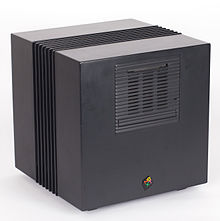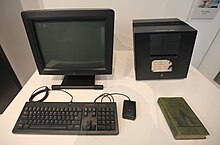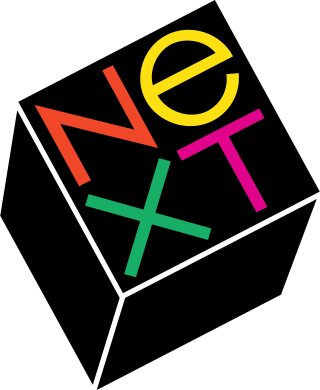
NeXT, Inc. was an American technology company headquartered in Redwood City, California that specialized in computer workstations for higher education and business markets, and later developed web software. It was founded in 1985 by CEO Steve Jobs, the Apple Computer co-founder who had been forcibly removed from Apple that year. NeXT debuted with the NeXT Computer in 1988, and released the NeXTcube and smaller NeXTstation in 1990. The series had relatively limited sales, with only about 50,000 total units shipped. Nevertheless, the object-oriented programming and graphical user interface were highly influential trendsetters of computer innovation.

NeXTSTEP is a discontinued object-oriented, multitasking operating system based on the Mach kernel and the UNIX-derived BSD. It was developed by NeXT Computer, founded by Steve Jobs, in the late 1980s and early 1990s and was initially used for its range of proprietary workstation computers such as the NeXTcube. It was later ported to several other computer architectures.
NeXT Computer is a workstation computer that was developed, marketed, and sold by NeXT Inc. It was introduced in October 1988 as the company's first and flagship product, at a price of US$6,500, aimed at the higher-education market. It was designed around the Motorola 68030 CPU and 68882 floating-point coprocessor, with a clock speed of 25 MHz. Its NeXTSTEP operating system is based on the Mach microkernel and BSD-derived Unix, with a proprietary GUI using a Display PostScript-based back end. According to the Science Museum Group, "The enclosure consists of a 1-foot die-cast magnesium cube-shaped black case, which led to the machine being informally referred to as 'The Cube.'"

The Amiga 2000 (A2000) is a personal computer released by Commodore in March 1987. It was introduced as a "big box" expandable variant of the Amiga 1000 but quickly redesigned to share most of its electronic components with the contemporary Amiga 500 for cost reduction. Expansion capabilities include two 3.5" drive bays and one 5.25" bay that could be used by a 5.25" floppy drive, a hard drive, or CD-ROM once they became available.
Apollo/Domain is a series of workstations that were developed and produced by Apollo Computer from c. 1980 to 1989. The machines were built around the Motorola 68k series of processors, except for the DN10000, which has from one to four of Apollo's RISC processors, named PRISM.
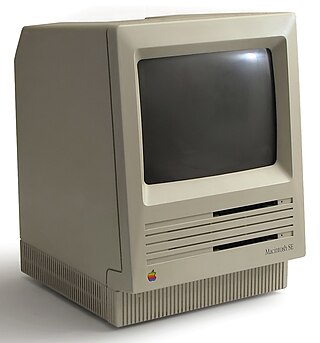
The Macintosh SE is a personal computer designed, manufactured, and sold by Apple Computer, from March 1987 to October 1990. It marked a significant improvement on the Macintosh Plus design and was introduced by Apple at the same time as the Macintosh II.

NeXTstation is a high-end workstation computer developed, manufactured and sold by NeXT from 1990 until 1993. It runs the NeXTSTEP operating system.

HP 9000 is a line of workstation and server computer systems produced by the Hewlett-Packard (HP) Company. The native operating system for almost all HP 9000 systems is HP-UX, which is based on UNIX System V.

The Macintosh Quadra 950 is a personal computer designed, manufactured and sold by Apple Computer from March 1992 to October 1995. It replaced the Quadra 900 that was introduced several months earlier, increasing the CPU clock rate of its 68040 CPU from 25 MHz to 33 MHz, and improving the graphics support. The two computers were otherwise identical, including the price. With a Macintosh Processor Upgrade Card installed, this computer is known as the Power Macintosh 950.

The SPARCstation 20 or SS20 is a discontinued Sun Microsystems workstation introduced in March 1994 based on the SuperSPARC or hyperSPARC CPU. It is one of the last models in the SPARCstation family of Sun "pizza box" computers, which was superseded by the UltraSPARC design in 1995.

The SPARCstation 10 is a workstation computer made by Sun Microsystems. Announced in May 1992, it was Sun's first desktop multiprocessor. It was later replaced with the SPARCstation 20.

SPARCstation 5 or SS5 is a workstation introduced by Sun Microsystems in March 1994. It is based on the sun4m architecture, and is enclosed in a pizza-box chassis. Sun also offered a SPARCserver 5 without a framebuffer. A simplified, cheaper version of the SS5 was released in February 1995 as the SPARCstation 4. Sun also marketed these same machines under the "Netra" brand, without framebuffers or keyboards and preconfigured with all the requisite software to be used as web servers. An estimated 400,000+ SPARCstation 5s were sold.
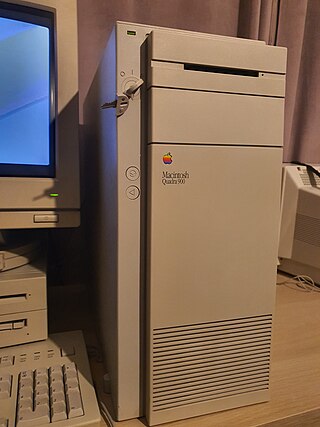
The Macintosh Quadra 900 is a personal computer designed, manufactured, and sold by Apple Computer from October 1991 to May 1992. It was introduced alongside the Quadra 700 as the first computers in the Quadra family of Macintosh computers using the Motorola 68040 processor. It is also the first computer from Apple to be housed in an 18.6 inch tall mid-tower form factor, which by 1991 had gained momentum with PC manufacturers as a suitable design for departmental servers.

MikroMikko was a Finnish line of microcomputers released by Nokia Corporation's computer division Nokia Data from 1981 through 1987. MikroMikko was Nokia Data's attempt to enter the business computer market. They were especially designed for good ergonomy.
The NeXTdimension (ND) is an accelerated 32-bit color board manufactured and sold by NeXT from 1991 that gave the NeXTcube color capabilities with PostScript planned. The NeXTBus (NuBus-like) card was a full size card for the NeXTcube, filling one of four slots, another one being filled with the main board itself. The NeXTdimension featured S-Video input and output, RGB output, an Intel i860 64-bit RISC processor at 33 MHz for Postscript acceleration, 8 MB main memory and 4 MB VRAM for a resolution of 1120x832 at 24-bit color plus 8-bit alpha channel. An onboard C-Cube CL550 chip for MJPEG video compression featured in the announced specification, but this was omitted from the delivered product. A handful of engineering prototypes for the MJPEG daughterboard exist.
The NeXT Laser Printer [NeXT PN N2000] was a 400 DPI PostScript laser printer, sold by NeXT from late 1988 to 1993 for the NeXTstation and NeXTcube workstations and manufactured by Canon Inc. It included an adjustable paper tray, which enabled it to print on several paper sizes including A4, letter-size, and those of legal and envelope varieties. It was very similar to other printers based on the Canon SX engine, such as the Apple LaserWriter II series and HP LaserJet II/III, although those other printers only printed at 300x300 dpi. Some parts are interchangeable with the LaserJet II/III.
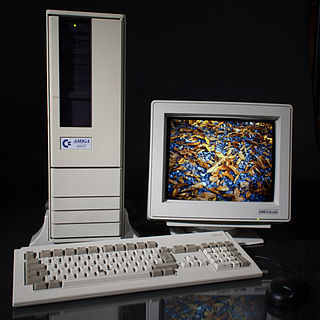
The Amiga 4000T, also known as A4000T, is a tower version of Commodore's A4000 personal computer. Using the AGA chipset, it was originally released in small quantities in 1994 with a 25 MHz Motorola 68040 CPU, and re-released in greater numbers by Escom in 1995, after Commodore's demise, along with a new variant which featured a 50 MHz Motorola 68060 CPU. Despite the subsequent demise of Escom, production was continued by QuikPak in North America into at least 1998.

The Sun Microsystems Ultra 80 is a computer workstation that shipped from November 1999 to 2002.

The NeXTcube Turbo is a high-end workstation computer developed, manufactured and sold by NeXT. It superseded the earlier NeXTcube workstation and is housed in the same cube-shaped magnesium enclosure. The workstation runs the NeXTSTEP operating system.
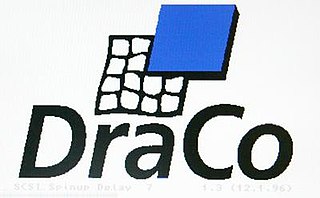
The DraCo, also known as DraCo Vision in one of its later models, was a non-linear video editing workstation created by MacroSystem Computer GmbH in 1994, based on the Amiga platform.
